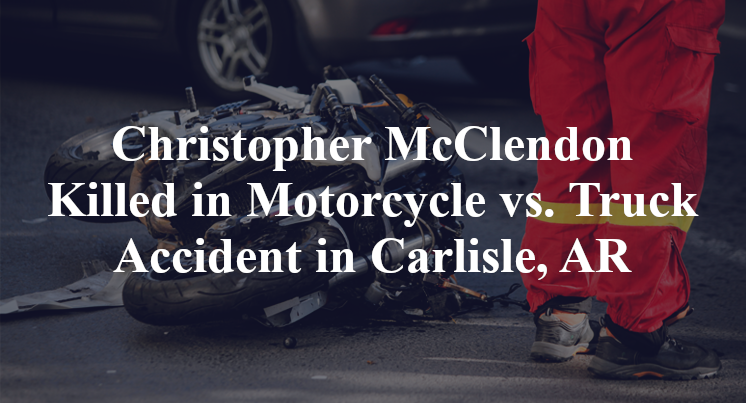Christopher McClendon Killed in Motorcycle vs. Truck Accident in Carlisle, AR
Lonoke County, AR — April 25, 2025, Christopher McClendon was killed in a motorcycle versus truck accident shortly before 6:45 p.m. along Interstate Highway 40.
According to authorities, 55-year-old Christopher McClendon was traveling on an eastbound Harley-Davidson motorcycle next to another Harley-Davidson in the vicinity of State Highway 13 when the accident took place. They were reportedly traveling behind a Peterbilt 18-wheeler.

Officials indicate that, for as yet unknown reasons, a collision took place between the second motorcycle and the rear-end of the Peterbilt. That caused the motorcycle to overturn, impacting McClendon's motorcycle. That impact caused his bicycle to lay over onto its right side in the next lane over. There, he was reportedly struck by the tires on the left side of a Freightliner 18-wheeler.
McClendon suffered fatal injuries due to the accident, according to reports. Additional details pertaining to this incident are not available at this point in time. The investigation is currently ongoing.
Commentary
In my experience, chain-reaction accidents involving motorcycles and large commercial vehicles are among the most complex to untangle—and the most devastating in outcome. When multiple 18-wheelers and motorcyclists are all involved in a matter of seconds, the margin for error disappears, and any slight miscalculation can spiral into consequences that no one can walk away from.
The key question in this scenario is how and why the first motorcycle collided with the rear of the Peterbilt. Was it a sudden slowdown? Did the truck brake abruptly or fail to maintain a consistent speed? Or was the motorcyclist following too closely, leaving no time to react? The answers to those questions are critical, because they not only explain what led to the initial impact, but also how it cascaded into a second collision that left Mr. McClendon fatally exposed to oncoming traffic.
It’s also worth examining the conduct of the second truck. While the Freightliner driver may have had little or no time to respond once McClendon’s motorcycle entered their lane, investigators still need to determine whether that driver was traveling at a safe speed, alert to their surroundings, and positioned properly within the lane. In high-speed environments like I-40, even split-second delays in recognition or response can make the difference between a close call and a fatal outcome.
If both trucks were operating under a commercial carrier, then that brings up additional considerations. Were the drivers trained to handle emergency situations with vulnerable road users like motorcyclists? Were there cameras or telematics systems in place that could offer a clearer picture of how the crash unfolded? And critically, did fatigue or distraction play any role in how the drivers responded—or failed to respond—to the developing hazard?
From where I sit, this wreck reflects just how little room for error there is when motorcycles and heavy trucks share the road. To understand what went wrong, the investigation must go beyond surface-level assumptions and take a hard look at timing, positioning, and decision-making from every party involved. That’s the only way to ensure accountability—and to give those affected the clarity and closure they deserve.

“These are essential reads for anyone dealing with the aftermath of a truck wreck”– Attorney Cory Carlson